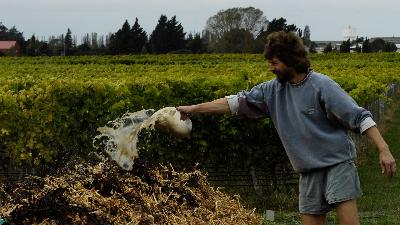
Many wineries have an issue with the waste generated from the production of wine. This waste is made up of the skins, stems and lees left over after the harvesting and processing of grapes. It is often difficult to dispose of due to the sheer volume and acidic nature of the waste. Sending it off-site means spending money and energy.
At FROMM WINERY we have turned our waste into gold. As our vineyards are fully certified biogro organic, we turn all of our waste into compost and then in the autumn spread it back into the vineyards in place of fertiliser. We also use sheep in the winter to graze the vineyards. This has many benefits for the soil and allows us to re-use the waste rather than purchasing fertiliser which would increase our carbon usage.
Creating the perfect compost takes a lot of time and planning. As we try to use everything from our own properties, any vineyard waste gets added to the mix. For example, if we trim the branches off a tree they would be shredded and kept to use as the base for the compost. Throughout the year we also collect cow poo from our organic cattle which helps accelerate the composting process. Seaweed is added to provide trace elements.
We have found the best way to get the perfect temperature in our compost is to layer it in a long line two metres high by two metres wide. This stops the compost from overheating. Layering of the materials so they are evenly dispersed throughout the compost enables even decomposition. Ideally, once the compost has been made, within three to five days the temperature should have risen to 55 degrees in order to kill diseases and weeds. For the first four weeks, the heat is caused by bacteria processing the green material. At this stage the temperature must not exceed 70 degrees otherwise beneficial fungi, which later break down the larger materials within the compost, will be destroyed.
After a year the compost is ready to put back into the vineyard. We spread it in the autumn, as this is when the vines are naturally shutting down and all the energy is being drawn back into the earth. By doing this, the nutrients and trace elements from the compost are freed up and become available for the grapevines to use in the spring.





